Imagine stepping into a home where every item has purpose and beauty, where space breathes freely, and stress melts away at the threshold. This isn’t a far-off dream or a scene from a high-end design magazine – it’s the reality of embracing minimalism in your home design. In a world cluttered with possessions and overwhelmed by choices, minimalism offers a refreshing alternative that’s both aesthetically pleasing and mentally liberating.
Minimalism in home design isn’t just about having less stuff; it’s about creating a space that reflects your values, enhances your well-being, and simplifies your daily life. It’s a design philosophy that champions the idea that less is more, focusing on quality over quantity and purpose over excess. By stripping away the unnecessary, minimalism allows the essential elements of your home to shine, creating an environment that’s both functional and beautiful.
At its core, minimalist home design is characterized by clean lines, uncluttered spaces, and a carefully curated selection of items. It embraces a neutral color palette, often with pops of color used sparingly for impact. Natural light plays a crucial role, as do high-quality materials and textures. But minimalism goes beyond just aesthetics – it’s a lifestyle choice that can lead to reduced stress, increased productivity, and a greater appreciation for the things you choose to keep in your life.
The benefits of adopting a minimalist approach to home design are numerous. Not only does it create visually appealing spaces, but it also makes cleaning and maintenance easier, reduces decision fatigue, and can even save you money in the long run by curbing unnecessary purchases. Moreover, a minimalist home can serve as a sanctuary from the chaos of the outside world, providing a calm and peaceful environment where you can relax, recharge, and focus on what truly matters to you.
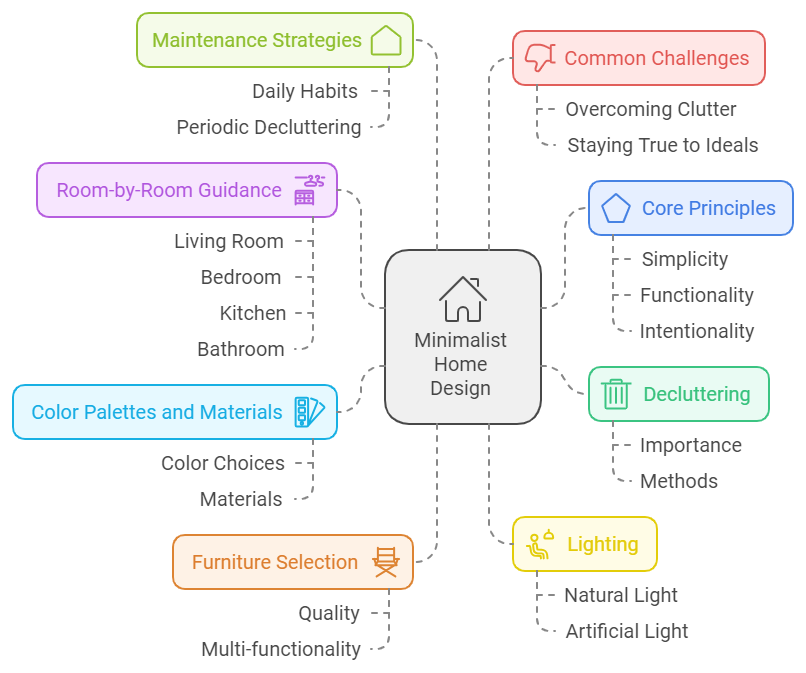
This comprehensive guide will walk you through the process of transforming your living space into a minimalist haven, enhancing both aesthetics and functionality. We’ll explore the principles of minimalist design, provide practical tips for decluttering and organizing, discuss how to choose furniture and decor that aligns with minimalist ideals, and offer room-by-room guidance for implementing minimalism throughout your home. Whether you’re looking to completely overhaul your living space or simply incorporate elements of minimalism into your existing decor, this guide will provide you with the knowledge and inspiration you need to create a home that’s both beautiful and purposeful.
Embark on this journey to simplify your space and, by extension, your life. Let’s discover how the art of minimalism can transform your home into a haven of tranquility and intentional living.
Understanding Minimalism in Home Design
Minimalism in home design is more than just a trend; it’s a philosophy that emphasizes simplicity, functionality, and intentionality in our living spaces. At its core, minimalist design is characterized by clean lines, uncluttered spaces, and a focus on essential elements. It’s about creating an environment that’s both visually appealing and purposeful, where every item has a reason for being there.
Definition of Minimalist Design
Minimalist design can be defined as an approach that strips away excessive ornamentation and unnecessary elements, leaving only what is essential for function and aesthetic appeal. It’s about achieving maximum impact with minimum means, creating spaces that are calm, ordered, and free from visual noise.
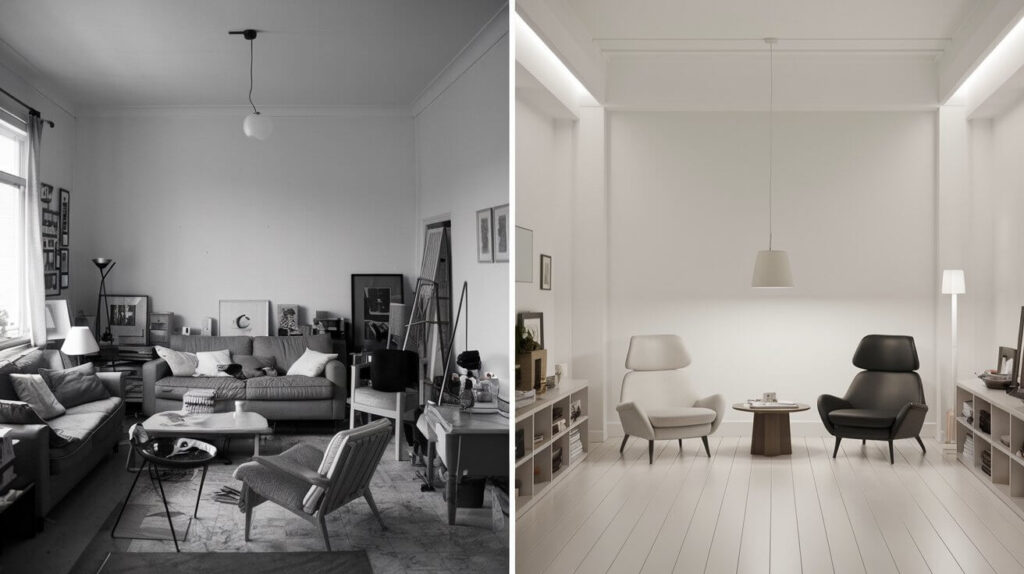
Key Principles
- “Less is More” Philosophy: This famous phrase, coined by architect Ludwig Mies van der Rohe, encapsulates the essence of minimalism. It suggests that simplicity and clarity lead to good design. In practice, this means carefully curating your possessions and design elements to include only those that add real value to your space and life.
- Focus on Functionality: Every item in a minimalist home should serve a purpose. This principle encourages us to question the necessity of each object and to prioritize items that are both useful and beautiful. Multifunctional furniture and smart storage solutions are often key components of minimalist interiors.
- Emphasis on Quality over Quantity: Rather than filling spaces with numerous inexpensive items, minimalism advocates for investing in fewer, high-quality pieces that will stand the test of time. This approach not only creates a more refined aesthetic but also promotes sustainability by reducing consumption and waste.
Benefits of Minimalist Home Design
- Reduced Stress and Improved Mental Clarity: A clutter-free environment can lead to a clutter-free mind. By eliminating excess stimuli and creating calm, organized spaces, minimalist design can significantly reduce stress and improve focus and mental well-being.
- Easier Cleaning and Maintenance: With fewer items to manage and clean around, maintaining a minimalist home is generally easier and less time-consuming. This can free up more time for activities you enjoy and reduce the mental load associated with household chores.
- Enhanced Aesthetic Appeal: Minimalist design often results in spaces that feel more open, airy, and visually pleasing. The careful curation of items and the emphasis on quality materials can create a sophisticated and timeless aesthetic that’s both beautiful and functional.
By understanding these fundamental aspects of minimalism in home design, you can begin to see how this approach might benefit your living space and lifestyle. Whether you’re looking to completely overhaul your home or simply incorporate elements of minimalism, these principles can guide you towards creating a more intentional and harmonious living environment.
Getting Started: The Decluttering Process
The journey to a minimalist home begins with decluttering. This process, while potentially challenging, is the foundation for creating a space that embodies minimalist principles. Decluttering isn’t just about getting rid of things; it’s about curating your possessions to align with your values and lifestyle.
Assessing Your Current Space
Start by taking a critical look at your living space. Walk through each room with fresh eyes, as if you’re seeing it for the first time. Notice areas that feel cluttered or cause stress. Identify spaces that don’t function well or items that haven’t been used in months. This initial assessment will help you prioritize your decluttering efforts and envision the potential of your space.
The KonMari Method for Decluttering
Marie Kondo’s famous KonMari method offers a structured approach to decluttering that aligns well with minimalist principles:
- Commit to tidying up: Make a conscious decision to transform your space.
- Imagine your ideal lifestyle: Visualize how you want your home to look and feel.
- Discard first, then organize: Focus on what to keep, not what to get rid of.
- Tidy by category, not location: Start with clothes, then books, papers, miscellaneous items (komono), and finally sentimental items.
- Ask yourself if each item sparks joy: Keep only those things that bring positive feelings and serve a purpose.
Categorizing Items: Keep, Donate, Discard
As you go through your belongings, sort them into three categories:
– Keep: Items that are essential, functional, or bring genuine joy
– Donate: Items in good condition that could benefit others
– Discard: Items that are broken, outdated, or no longer useful
Be honest with yourself during this process. If you haven’t used an item in the past year and it doesn’t hold significant sentimental value, it’s likely a candidate for donation or disposal.
Digital Decluttering for a Holistic Approach
Don’t forget about digital clutter. In our increasingly digital world, virtual mess can be just as stressful as physical clutter. Take time to:
– Organize digital files and photos
– Unsubscribe from unnecessary emails
– Delete unused apps from your devices
– Clean up your social media feeds
By decluttering both your physical and digital spaces, you create a more comprehensive minimalist lifestyle.
Remember, decluttering is a process, not a one-time event. Be patient with yourself and celebrate small victories along the way. As you let go of excess possessions, you may find yourself feeling lighter, more focused, and more in control of your environment. This cleared space will provide the perfect canvas for implementing minimalist design principles in your home.
Minimalist Color Palettes and Materials
In minimalist home design, the choice of colors and materials plays a crucial role in creating a serene, uncluttered atmosphere. The right palette and textures can transform a space, making it feel open, calm, and purposeful. Let’s explore how to select and implement colors and materials that embody minimalist principles.
Choosing a Base Color Scheme
Minimalist design typically relies on a neutral color palette as its foundation. This doesn’t mean your space has to be stark or boring; rather, it’s about creating a harmonious backdrop that allows key elements to shine.
- Neutral Tones and Their Psychological Effects
– Whites and creams: Create a sense of spaciousness and light, promoting clarity and freshness.
– Grays: Add depth and sophistication, offering a modern and calming effect.
– Beiges and taupes: Bring warmth and earthiness, creating a cozy yet uncluttered feel.
These neutral tones have psychological effects, promoting calmness and clarity. They also provide a versatile backdrop that can easily adapt to changing tastes or seasons with simple accessory swaps.

- Accent Colors in Minimalism
While neutrals dominate, don’t be afraid to use accent colors sparingly. A pop of color in artwork, a throw pillow, or a vase can add interest without overwhelming the space. Consider:
– Soft pastels for a subtle touch of color
– Bold primaries for a striking contrast
– Natural hues like sage green or terracotta for an organic feel
The key is to use these accents thoughtfully and sparingly to maintain the minimalist aesthetic.
Materials that Embody Minimalist Principles
The materials you choose can significantly impact the look and feel of your minimalist space. Opt for high-quality, durable materials that age well and require minimal maintenance.
- Natural Materials:
– Wood: Brings warmth and texture, connecting the space to nature.
– Stone: Offers durability and a timeless quality.
– Cotton and linen: Provide comfort and a soft, organic feel.
- Modern Materials:
– Glass: Creates an illusion of more space and allows light to flow.
– Steel: Adds a sleek, contemporary touch.
– Concrete: Offers a raw, industrial aesthetic that can be surprisingly warm when balanced with softer elements.
Textures in Minimalist Design
Texture plays a vital role in minimalist design, adding depth and interest without relying on patterns or bold colors.
- Balancing Smooth and Rough Textures:
– Combine smooth surfaces (like polished concrete floors) with rough textures (such as a woven jute rug).
– Use textured fabrics for upholstery to add depth without patterns.
– Incorporate natural textures through plants or wooden elements.
- Creating Interest Without Clutter:
– Use textured wallpaper on an accent wall.
– Choose furniture with interesting textures, like a leather armchair or a raw wood coffee table.
– Add subtle texture through window treatments, like linen curtains or woven blinds.
By carefully selecting colors, materials, and textures, you can create a minimalist space that’s far from boring. The key is to focus on quality over quantity, choosing each element with intention and purpose. This approach results in a home that feels cohesive, calming, and thoughtfully designed, embodying the essence of minimalist principles.
Furniture Selection for Minimalist Spaces
Choosing the right furniture is crucial in creating a minimalist home that balances form and function. The goal is to select pieces that serve your needs while maintaining a clean, uncluttered aesthetic. Let’s explore how to choose and arrange furniture in a minimalist space.
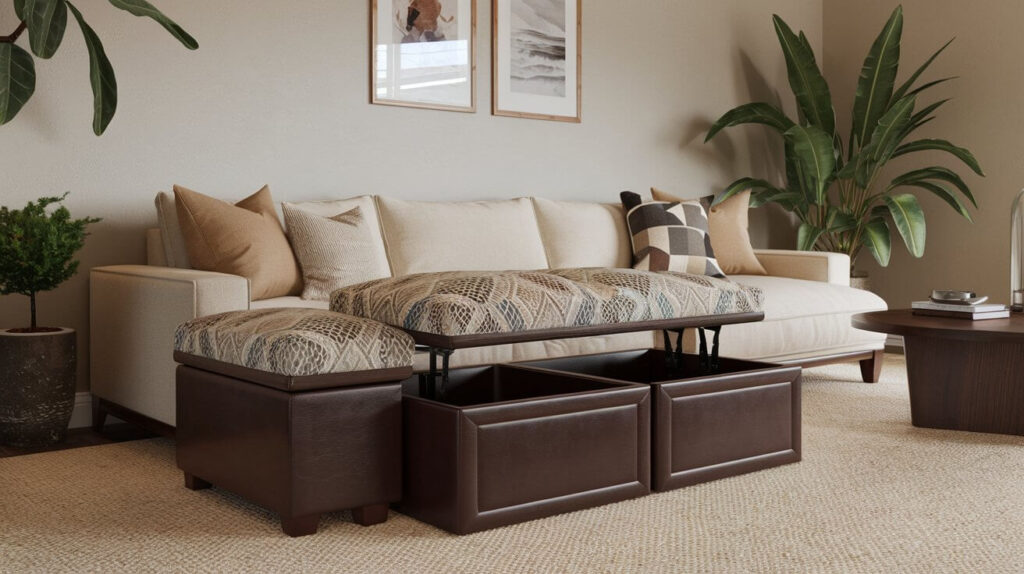
Multi-functional Furniture Pieces
In minimalist design, every item should earn its place by serving a clear purpose – or better yet, multiple purposes. Multi-functional furniture is key to maximizing space and minimizing clutter.
– Storage ottomans that double as seating and hide away blankets or magazines
– Expandable dining tables that can accommodate guests but remain compact for daily use
– Murphy beds or sofa beds that transform spaces from day to night
– Nesting tables that can be separated for use and tucked away when not needed
– Modular shelving systems that can be reconfigured as your needs change
By choosing pieces that serve multiple functions, you can reduce the total number of furniture items in your space while maintaining or even enhancing functionality.
Choosing Quality Over Quantity
Minimalism emphasizes investing in fewer, high-quality pieces rather than filling spaces with numerous cheap items. This approach not only aligns with minimalist aesthetics but also promotes sustainability and long-term value.
– Invest in well-crafted furniture made from durable materials
– Choose classic designs that won’t quickly go out of style
– Consider the longevity and versatility of each piece before purchasing
– Opt for furniture with timeless appeal rather than following short-lived trends
Remember, it’s better to have one beautifully crafted chair that you love than several mediocre ones that clutter your space.
Proper Scaling for Your Space
Selecting furniture that fits your space properly is essential in minimalist design. Oversized furniture can make rooms feel cramped, while pieces that are too small can look out of place and disrupt the balance of the room.
– Measure your rooms and doorways before purchasing furniture
– Use painter’s tape on the floor to outline the dimensions of potential furniture pieces
– Consider the flow of traffic and leave ample space for movement
– Choose furniture with legs to create a sense of openness and light
– In smaller spaces, opt for furniture with a lower profile to maintain an airy feel
Storage Solutions that Maintain Minimalist Aesthetics
Effective storage is crucial in maintaining a clutter-free minimalist home. Look for storage options that keep items out of sight while complementing your minimalist aesthetic.
– Built-in cabinets that blend seamlessly with walls
– Floating shelves for displaying a few carefully chosen items
– Under-bed storage containers for items used less frequently
– Furniture with hidden storage compartments, like beds with drawers or coffee tables with lift-tops
– Wall-mounted systems that keep floor space clear
When selecting storage solutions, prioritize simplicity and functionality. Choose pieces with clean lines and minimal ornamentation to maintain the minimalist look.
By carefully selecting furniture that is multi-functional, high-quality, properly scaled, and offers smart storage solutions, you can create a minimalist space that is both beautiful and highly functional. Remember, in minimalist design, each piece of furniture should serve a purpose and contribute to the overall sense of calm and order in your home.
Minimalist Design Room by Room
Applying minimalist principles to each room in your home requires a tailored approach. Each space has unique functions and challenges, but the core principles of simplicity, functionality, and intentionality remain constant. Let’s explore how to implement minimalist design in key areas of your home.
Living Room
The living room is often the heart of the home, where family and friends gather. Creating a minimalist living room involves balancing comfort with simplicity.
- Focal Points and Negative Space
– Choose one main focal point, such as a piece of art or a statement furniture item
– Allow for ample negative space to create a sense of openness
– Arrange furniture to promote conversation and flow
- Minimalist Entertainment Centers
– Opt for wall-mounted TVs to reduce visual clutter
– Choose streamlined media consoles with hidden storage for electronics and media
– Consider built-in solutions that integrate seamlessly with the room’s design
- Seating and Decor
– Select a sofa with clean lines and neutral upholstery
– Limit throw pillows and blankets to a few high-quality pieces
– Use plants to add life and color without cluttering the space
Bedroom
The bedroom should be a serene retreat that promotes rest and relaxation. Minimalist bedroom design focuses on creating a calm, clutter-free environment.
- Creating a Serene Sleep Environment
– Choose a simple, platform bed frame or a bed without a footboard to create a sense of space
– Opt for high-quality, neutral bedding with minimal patterns
– Keep nightstands clear, with just essential items like a lamp and a book
- Minimalist Closet Organization
– Implement a capsule wardrobe to reduce clothing clutter
– Use matching hangers and organizers for a cohesive look
– Consider removing closet doors and using curtains for a softer, more open feel
- Lighting and Ambiance
– Maximize natural light with sheer window treatments
– Choose soft, dimmable lighting options for a calming atmosphere
– Limit decor to a few meaningful pieces that promote tranquility
Kitchen
A minimalist kitchen focuses on functionality and cleanliness, creating a space that’s efficient and pleasant to use.
- Streamlining Appliances and Utensils
– Keep only frequently used appliances on countertops
– Store lesser-used items in cabinets or a pantry
– Curate your utensil collection, keeping only what you regularly use
- Open Shelving vs. Hidden Storage
– Consider a mix of open shelving for frequently used items and closed cabinets for everything else
– If using open shelving, display items in a curated, organized manner
– Use drawer organizers and cabinet solutions to maximize hidden storage
- Minimalist Kitchen Decor
– Opt for a neutral color palette with perhaps one accent color
– Choose sleek, handle-less cabinet designs for a clean look
– Use natural materials like wood or stone to add warmth and texture
Bathroom
A minimalist bathroom can feel like a personal spa, offering a clean and calming space to start and end your day.
- Spa-like Minimalism
– Choose a neutral color scheme with whites, grays, or earth tones
– Opt for a frameless glass shower enclosure to create an open feel
– Use natural materials like stone or wood to add warmth
- Clever Storage for Essentials
– Install floating vanities to create a sense of space
– Use drawer organizers to keep toiletries tidy and out of sight
– Consider recessed shelving in shower areas for a sleek look
- Minimalist Bathroom Accessories
– Choose high-quality, coordinated accessories like towels and bath mats
– Limit countertop items to essentials in attractive, matching containers
– Add a single plant or piece of art for a touch of life and color
By applying these minimalist principles room by room, you can create a cohesive, calming home environment. Remember, the key is to focus on functionality, choose quality over quantity, and create spaces that reflect your personal style while maintaining a sense of simplicity and purpose.
Lighting in Minimalist Design
Lighting plays a crucial role in minimalist design, not only for its functional purpose but also for its ability to enhance the aesthetic and mood of a space. Proper lighting can make rooms feel larger, more open, and more inviting. Let’s explore how to effectively use lighting in a minimalist home.
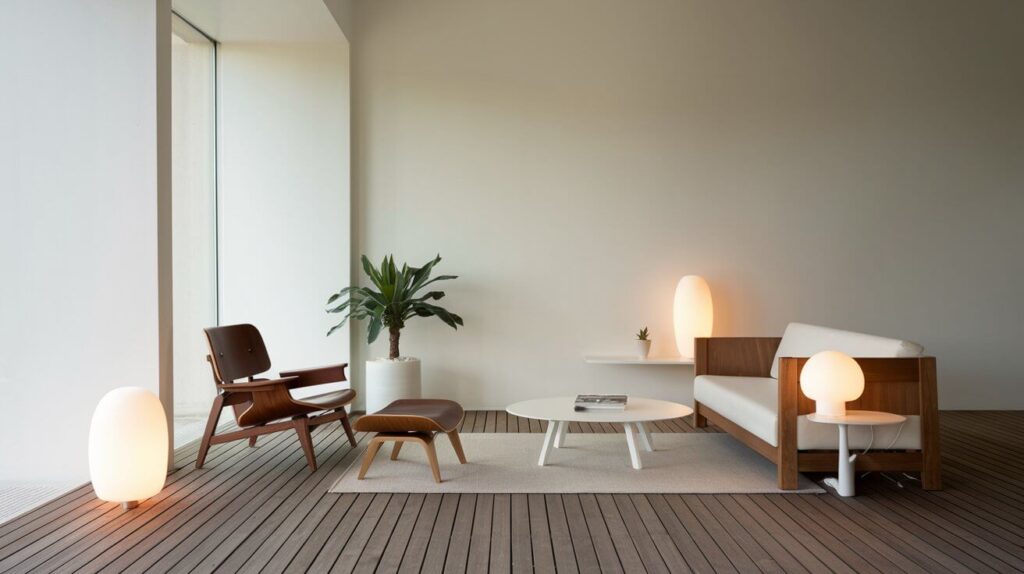
Maximizing Natural Light
Natural light is a cornerstone of minimalist design, creating an open and airy feel while connecting indoor spaces with the outside world.
- Keep Windows Unobstructed
– Use minimal window treatments or opt for sheer curtains that allow light to filter through
– Position furniture to avoid blocking windows
– Consider removing unnecessary walls or replacing solid doors with glass ones to allow light to flow between rooms
- Use Light, Reflective Colors
– Paint walls in light, neutral colors to reflect and amplify natural light
– Choose light-colored flooring or add a large, light-colored rug to brighten the space
– Use mirrors strategically to bounce light around the room
- Consider Skylights or Solar Tubes
– For rooms with limited windows, consider adding skylights or solar tubes to bring in natural light from above
– These additions can dramatically transform dark spaces without compromising privacy
Choosing Minimalist Light Fixtures
When selecting artificial lighting, opt for fixtures that complement the clean lines and simplicity of minimalist design.
- Simple, Geometric Designs
– Choose light fixtures with clean lines and simple shapes
– Consider pendant lights with minimal designs for a modern, uncluttered look
– Opt for recessed lighting in areas where you want to maintain a sleek ceiling line
- Hidden or Integrated Lighting
– Use LED strip lighting under cabinets or along baseboards for subtle illumination
– Consider cove lighting to create a soft, ambient glow without visible fixtures
– Integrate lighting into shelving units or behind mirrors for a streamlined appearance
- Statement Pieces
– While minimalism favors simplicity, a single statement light fixture can serve as a focal point
– Choose a piece that aligns with minimalist principles in its form and materials
The Impact of Proper Lighting on Space Perception
Strategic lighting can significantly affect how spacious and welcoming a room feels.
- Layered Lighting
– Combine ambient, task, and accent lighting to create depth and interest
– Use dimmers to adjust light levels and create different moods throughout the day
- Highlighting Architectural Features
– Use lighting to draw attention to interesting architectural elements or textures
– Wall sconces or uplighting can emphasize the height of a room
- Creating Zones in Open Spaces
– Use lighting to define different areas in open-plan spaces
– Pendant lights over a dining table or a floor lamp next to a reading chair can create distinct zones without physical barriers
- Avoiding Harsh Shadows
– Position lights to minimize harsh shadows, which can make a space feel smaller
– Use diffused light sources or bounce light off walls and ceilings for a softer effect
Smart Lighting Solutions
Incorporating smart lighting technology can enhance both the functionality and minimalist aesthetic of your home.
- Programmable Lighting Systems
– Use smart bulbs or switches that can be controlled via smartphone or voice commands
– Set lighting schedules to automatically adjust throughout the day
- Motion Sensors
– Install motion-activated lights in areas like closets or pantries to eliminate the need for visible switches
- Color Temperature Adjustment
– Choose bulbs that allow you to adjust color temperature, mimicking natural light cycles and promoting better sleep patterns
By thoughtfully considering both natural and artificial lighting, you can create a minimalist space that feels open, welcoming, and perfectly illuminated at any time of day. Remember, in minimalist design, lighting should enhance the space without drawing unnecessary attention to itself, creating a harmonious and functional environment.
Maintaining a Minimalist Home
Creating a minimalist home is one thing, but maintaining it is an ongoing process that requires commitment and mindfulness. By developing good habits and regularly reassessing your space, you can ensure that your minimalist home continues to serve you well over time.
Daily Habits for Clutter Prevention
Preventing clutter from accumulating is key to maintaining a minimalist home. Incorporate these habits into your daily routine:
- One In, One Out Rule
– For every new item you bring into your home, remove one similar item
– This helps maintain balance and prevents gradual accumulation of possessions
- Immediate Action on Mail and Papers
– Sort mail as soon as it arrives, recycling junk mail immediately
– Digitize important documents and recycle the physical copies when possible
– Develop a simple filing system for papers you need to keep
- Daily Reset Routine
– Spend 10-15 minutes each evening returning items to their designated places
– Make bed-making a daily habit to maintain a tidy bedroom
– Clean as you go, especially in the kitchen and bathroom
- Mindful Consumption
– Before making a purchase, ask yourself if the item is truly necessary
– Consider the long-term value and purpose of potential purchases
– Wait 24-48 hours before buying non-essential items to avoid impulse purchases
Regular Reassessment of Possessions
Even with good daily habits, it’s important to periodically review your belongings:
- Seasonal Decluttering Sessions
– Schedule quarterly decluttering sessions to coincide with changing seasons
– Focus on one area or category at a time (e.g., clothing, books, kitchen items)
– Use this time to reassess whether items still serve a purpose or bring joy
- Rotation System for Decor and Clothing
– Store seasonal items when not in use to keep spaces clutter-free
– Rotate decorative items to keep your space feeling fresh without accumulating more
- Digital Decluttering
– Regularly clean up digital files, unsubscribe from unnecessary emails
– Organize photos and delete duplicates or low-quality images
Mindful Purchasing Practices
Thoughtful consumption is crucial for maintaining a minimalist home:
- Quality Over Quantity
– Invest in high-quality items that will last longer and serve you better
– Consider the cost per use rather than just the upfront price
- Multi-functional Items
– Prioritize items that serve multiple purposes to reduce overall possessions
- Conscious Shopping List
– Keep a running list of items you need and stick to it when shopping
– Allow yourself time to consider whether a desired item truly fits your minimalist lifestyle
- Experiences Over Things
– When possible, opt for experiences rather than physical gifts or purchases
– This can enrich your life without adding clutter to your home
Adapting to Life Changes
As your life evolves, your minimalist home should adapt:
- Regular Space Audits
– Periodically assess how well your space is serving your current needs
– Be willing to rearrange or repurpose areas as your lifestyle changes
- Flexible Storage Solutions
– Use modular or adjustable storage systems that can evolve with your needs
– This allows you to maintain a minimalist aesthetic while accommodating life changes
- Mindful Expansion
– If you need to add items due to life changes (e.g., having a baby), do so thoughtfully
– Look for ways to incorporate new necessities without compromising your minimalist principles
By incorporating these practices into your daily life, you can maintain the serenity and functionality of your minimalist home. Remember, minimalism is not about perfection, but about intentionality. It’s okay to adjust your approach as needed, as long as you stay true to the core principles of living with less and focusing on what truly matters to you.
Overcoming Challenges in Minimalist Design
While minimalist design offers numerous benefits, it can also present challenges. Addressing these challenges head-on will help you create a minimalist home that’s both beautiful and functional, without feeling sterile or impersonal.
Balancing Minimalism with Personal Style
One of the biggest concerns people have about minimalism is losing their personal style. Here’s how to maintain your individuality within a minimalist framework:
- Curate a Signature Style
– Identify key elements of your personal style and incorporate them thoughtfully
– Choose a few statement pieces that reflect your personality
– Use color accents that resonate with you, even if they’re bold
- Display Meaningful Items
– Select a few cherished possessions or artworks to showcase
– Rotate these items periodically to keep your space feeling fresh
- Incorporate Texture
– Use different textures in fabrics, materials, and finishes to add depth and interest
– This allows for visual variety without cluttering the space
Adapting Minimalism for Families with Children
Maintaining a minimalist home with children can seem daunting, but it’s not impossible:
- Teach Children the Value of Quality Over Quantity
– Involve kids in the decluttering process, teaching them to prioritize
– Encourage thoughtful gift-giving and receiving
- Implement Smart Storage Solutions
– Use closed storage for toys and school supplies to maintain a clean look
– Teach children to tidy up regularly, making it a fun routine
- Create Designated Play Areas
– Dedicate specific areas for play, allowing some ‘controlled chaos’
– Use attractive, minimalist storage solutions in these areas
- Rotate Toys and Books
– Keep a portion of toys and books in storage, rotating them periodically
– This keeps things fresh for children while maintaining a clutter-free environment
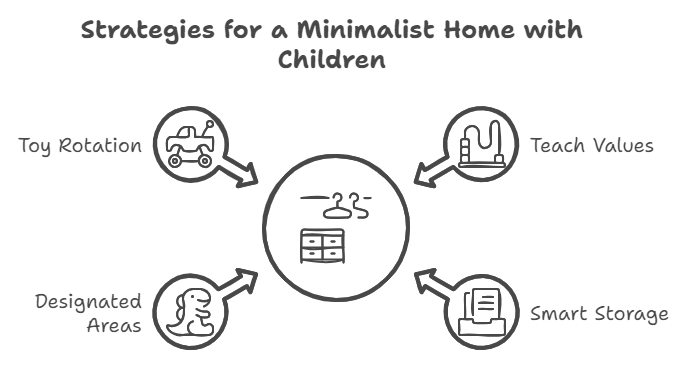
Incorporating Sentimental Items into a Minimalist Space
Balancing sentimentality with minimalism can be challenging:
- Display Selectively
– Choose a few meaningful items to display prominently
– Consider creating a dedicated memory corner or shelf
- Digitize When Possible
– Scan old photos and documents to preserve memories without physical clutter
– Create digital photo albums or scrapbooks
- Repurpose Sentimental Items
– Find functional uses for sentimental objects (e.g., using a family heirloom as a key holder)
– This honors the item while giving it a purpose in your daily life
Dealing with Shared Spaces and Different Preferences
When living with others who may not share your minimalist ideals:
- Compromise on Shared Areas
– Agree on a level of minimalism for common spaces that everyone can live with
– Allow for personal expression in private spaces like bedrooms
- Lead by Example
– Demonstrate the benefits of minimalism through your own spaces and habits
– Be patient and avoid forcing your preferences on others
- Find Creative Solutions
– Use attractive storage solutions to keep non-minimalist items out of sight in shared spaces
– Designate specific areas for different family members’ styles or needs
Maintaining Warmth in a Minimalist Space
A common concern is that minimalist spaces can feel cold or uninviting:
- Incorporate Natural Elements
– Add plants to bring life and color to your space
– Use natural materials like wood, stone, or woven textiles for warmth
- Focus on Lighting
– Use warm, soft lighting to create a cozy atmosphere
– Layer different types of lighting for flexibility
- Choose Warm Colors and Textures
– Even within a neutral palette, opt for warmer tones
– Use plush textures in furnishings and textiles to add comfort
By addressing these challenges proactively, you can create a minimalist home that reflects your personal style, accommodates family life, honors sentimental attachments, and feels warm and inviting. Remember, minimalism is not about adhering to strict rules, but about creating a space that enhances your life and aligns with your values. It’s okay to adapt and find your own version of minimalism that works for you and your household.
-
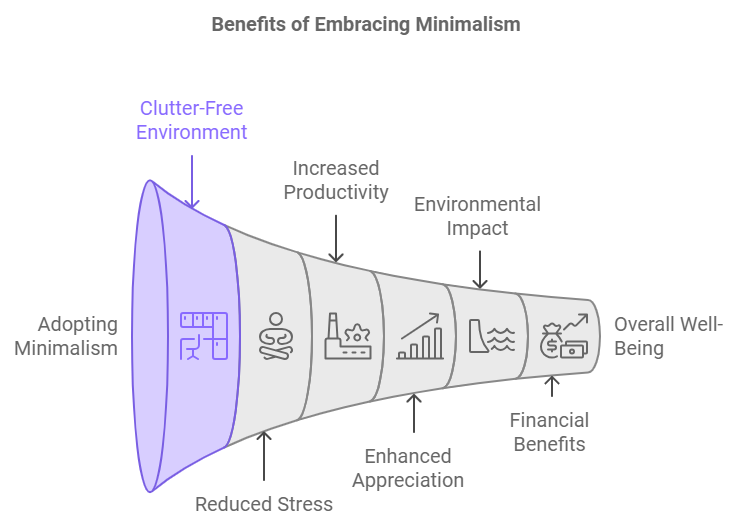
Benefits of Embracing Minimalism
Encouragement to Start the Minimalist Journey
Remember, incorporating minimalism into your home design is a personal journey. There’s no one-size-fits-all approach, and it’s okay to adapt these principles to fit your unique lifestyle and preferences. The key is to start small and be patient with yourself:
- Begin with one room or even one corner of a room.
- Focus on progress, not perfection.
- Be open to evolving your approach as you learn what works best for you.
- Celebrate small victories along the way.
We encourage you to take the first step towards a more minimalist home today. Here are some actionable steps you can take right now:
- Choose one area of your home to declutter this week.
- Identify three items you can donate or discard that no longer serve a purpose in your life.
- Take a photo of a space in your home you’d like to simplify, and visualize how you want it to look.
- Share your minimalist journey with friends or on social media to inspire others and stay accountable.
Final Thoughts
Incorporating minimalism into your home design is not just about creating a beautiful space; it’s about crafting an environment that supports and enhances your life. As you embark on this journey, remember that the goal is not to achieve a perfect, magazine-worthy home, but to create a space that brings you peace, joy, and functionality.
Your minimalist home should be a reflection of your best self – a place where you can relax, recharge, and focus on what truly matters to you. Embrace the process, be kind to yourself, and enjoy the serenity and clarity that comes with living with less.
As you move forward, we invite you to share your experiences, challenges, and triumphs in your minimalist home design journey. Your story could be the inspiration someone else needs to begin their own path to a simpler, more intentional living space.
Frequently Asked Questions (FAQ)
To address common concerns and provide additional clarity, here’s a list of frequently asked questions about incorporating minimalism into home design:
- Q: Is minimalist design cold and uninviting?
A: Not necessarily. While minimalist design favors clean lines and a neutral palette, it can be warm and inviting through the use of textures, natural materials, and carefully chosen accent pieces. The key is to balance simplicity with elements that add warmth and personality to your space.
- Q: How do I start incorporating minimalism into my home?
A: Start small. Begin with one room or even one drawer. Declutter, keeping only what you need and love. Gradually expand this practice to other areas of your home. Focus on creating a clean, uncluttered look with a neutral color palette and multi-functional furniture.
- Q: Can minimalism work for families with children?
A: Absolutely. Minimalism can teach children valuable lessons about materialism and help create a more organized, peaceful home environment. The key is to implement smart storage solutions, rotate toys, and involve children in the process of decluttering and organizing.
- Q: How do I maintain a minimalist home long-term?
A: Maintaining a minimalist home requires ongoing effort. Develop daily habits like the “one in, one out” rule, regular decluttering sessions, and mindful purchasing practices. Continuously reassess your possessions and space to ensure they align with your current needs and lifestyle.
- Q: Is minimalist design expensive?
A: While minimalism often involves investing in quality pieces, it can actually save money in the long run by reducing impulse purchases and focusing on items that truly add value to your life. You don’t need to buy expensive items to achieve a minimalist look; the key is in thoughtful curation and simplicity.
- Q: How do I incorporate color in a minimalist design?
A: While minimalism is often associated with neutral colors, you can incorporate color through accent pieces, artwork, or even a feature wall. The key is to use color intentionally and sparingly to maintain the clean, uncluttered feel of minimalist design.
- Q: Can I be a minimalist if I love collecting things?
A: Yes, you can. Minimalism is about intentionality, not deprivation. If your collection brings you joy and serves a purpose in your life, display it thoughtfully. The key is to curate your collection carefully and ensure it doesn’t overwhelm your space.
- Q: How do I deal with sentimental items in a minimalist home?
A: For sentimental items, be selective about what you keep and display. Consider digitizing photos and documents. For physical items, choose a few meaningful pieces to showcase and find creative ways to repurpose others. Remember, the memories are in you, not in the objects.
- Q: Is minimalism just another trend?
A: While minimalism has gained popularity in recent years, its principles of simplicity and intentionality are timeless. Minimalism is more of a lifestyle choice than a fleeting trend, offering lasting benefits like reduced stress and increased focus on what truly matters.
- Q: How do I balance minimalism with my personal style?
A: Minimalism doesn’t mean sacrificing personal style. Incorporate your style through carefully chosen statement pieces, textures, and subtle color accents. The key is to express your personality in a curated, intentional way that aligns with minimalist principles.
These FAQs address some of the most common concerns and misconceptions about minimalist home design. Remember, minimalism is a flexible concept that can be adapted to suit your individual needs and preferences. The goal is to create a space that enhances your life and brings you peace and clarity.
